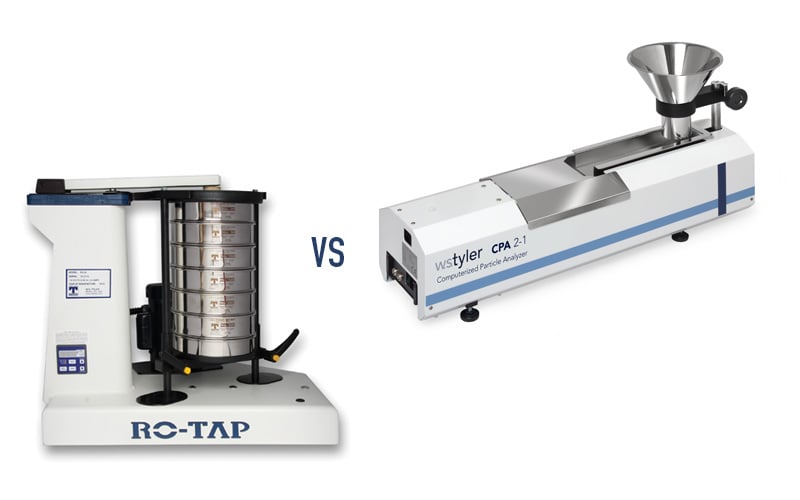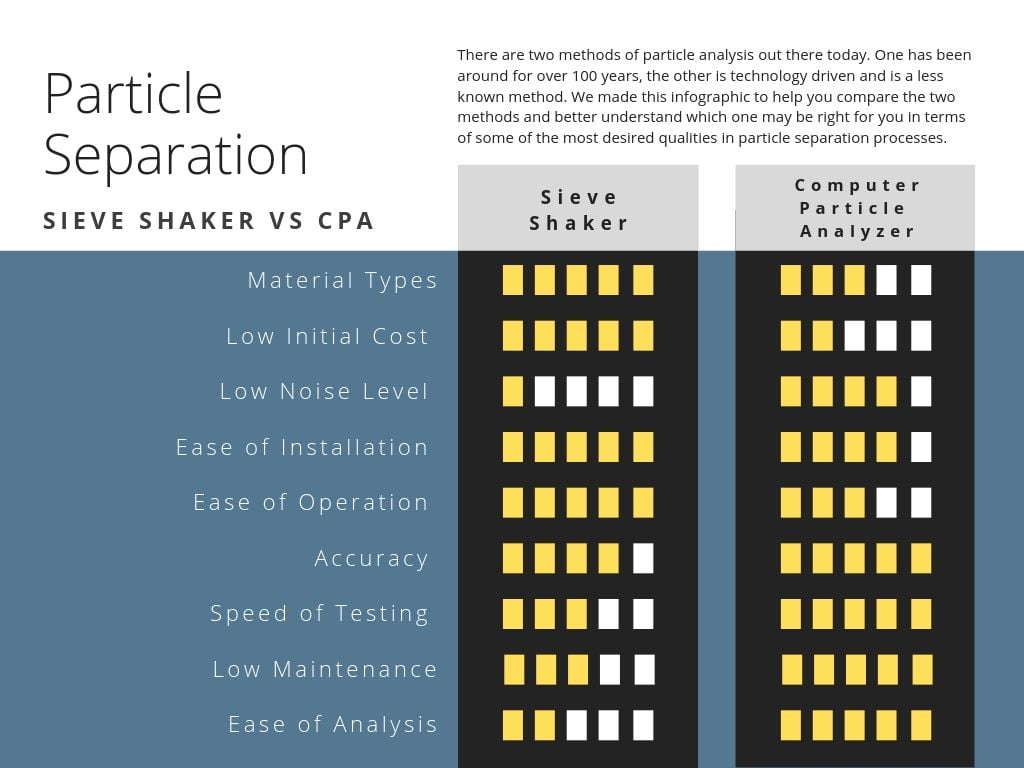Sieve Shaker vs. Computerized Particle Analyzer (CPA)
Here at W.S. Tyler, we have been in the business of particle analysis and sieving for over 150 years. Over the years, a lot of things have changed in the world of separation and particle analysis, and others have stayed just the same.
We offer two different products that were created to do the same thing, separate and analyze particles. We created one of these products over 100 years ago and the other about 25 years ago.
Those two systems are a sieve shaker and a computer particle analyzer.
These products are built for the same purpose, but the way they achieve the result, the skill it takes, and the cost of the system are very different.
We want to help you understand each product and how it compares to the other so you can make a better-informed decision on which one may be right for your business.
Read our articles about the Ro-Tap Sieve Shaker and the Computer Particle Analyzer for more detail about the models and how each one works.
For the sake of this article, we want to take a look at each product and how they compare in the following areas:
- Material Types (product being sieved)- Cost
- Noise Level
- Installation
- Ease of Operation
- Accuracy
- Speed of Testing
- Maintenance
- Ease of Analysis
Material Type (product able to be sieved)
Sieve Shaker
A sieve shaker is able to sieve pretty much any material you need it to. Wet, dry, large, small all the way down to 20 microns. This is all dependent on the sieves you use in your shaker.
Computer Particle Analyzer
The CPA uses a camera to analyze the particles. Because of this, you can only use non-agglomerated particles. If your particles stick together, the camera is unable to analyze each particle.
Cost
Sieve Shaker
There are lots of different models of sieve shakers, but a good estimate when it comes to cost is around $1,975.28 to $11,005.80. This includes the shaker itself and the test sieves that are needed to perform the analysis. If you want to see all the models of sieve shakers we sell, you can check out our guide to Ro-Tap Sieve Shaker pricing here.
Computer Particle Analyzer
The CPA is a technology-driven product. It is designed to run with a computer and customized software. If you are purchasing a CPA, you can expect to pay at least $60,000 (this price varies and can exceed $100,000) dollars for the entire system and package. If you want to see a full breakdown of what is included in this cost, you can read our article all about Computer Particle Analyzer Pricing.
Noise Level
Sieve Shakers
Because of the way a sieve shaker is designed, they can be quite noisy. The Ro-Tap Sieve Shaker was designed to use a "hammer" to assist in the agitation of particles to help them find the sieve openings. The machine runs at around 85dB. To help with the noise, you can purchase a sound enclosure cabinet. The noise level can increase depending on the types of material you are testing.
Computer Particle Analyzer
The CPA is much quieter than a sieve shaker. The main contributing factors to the noise level are the vibratory feeder and the particles dropping into the collection pan. This is a great alternative to a sieve shaker if noise can be a distraction.
Installation
Sieve Shakers
When you purchase a sieve shaker, it is a plug and play unit. An instruction manual is included to guide the set-up but it is nothing a lab technician or operator can’t handle. There are a few parts to set up, and then it is as simple as plugging the machine in, adding your sieve stack and you are ready to run your samples.
Computer Particle Analyzer
Installation of a CPA requires an on-site visit from a W.S. Tyler technician. Our CPA expert will come to your facility to install the machine and train your team on its capabilities. We make sure that before we leave your company you are set up and running at full speed.
Ease of Operation
Sieve shakers
Shakers have been around for a long time and they are pretty standard. They are not overly complicated machines that are hard to run. They do have a lot of parts and are still an operating machine, but they don’t require a lot of technical skill or experience.
Computer Particle Analyzer
When it comes to using the CPA, it is a bit of a different story. The CPA is a complex piece of equipment that includes a computer with specialized software that is used to analyze all of the data recorded from the sample.
We have a dedicated specialist on our team who provides in-depth training to your technicians. After two days working with our technician, your team will be fully prepared for daily operations, analyzing your material with the click of a button. You will probably need someone who has been trained to run and operate the CPA.
Accuracy/Repeatability
Sieve Shakers
One of the main things to keep in mind when sieving, with either test sieves alone or in a sieve shaker, is human error. Even though the Ro-Tap is doing the physical shaking and motion, there is still a possibility for human error in reporting or analyzing.
Computer Particle Analyzer
Since the CPA is run with a computer and software, there is much less room for error. The repeatability of your testing is essentially guaranteed, and there is no risk of someone doing something differently than the time before.
Time and Speed
Sieve Shakers
The average time it takes to run a sieve analysis on a Ro-Tap is 8-10 minutes. You will need to run a few test analysis first to determine the exact time for your material. This does not include the time of analyzing the results. This is usually fine for people who are not doing more than a few tests a day or who aren’t running their machine all day.
Computer Particle Analyzer
This is one place that the CPA has a definite advantage over a sieve shaker. The CPA can run a test on a sample in about three minutes. This can vary depending on your particle size but three minutes is a good estimate.
Keep in mind this test is done with the same accuracy, or greater, than the sieve shaker in a fraction of the time. This is ideal if you are in an industry that calls for tests to be run constantly throughout the day, for example, a test every hour or testing requiring multiple people’s daily attention.
Data and Reporting
Sieve Shakers
When doing a sieve analysis with a sieve shaker, you are getting particle size distribution analysis. You are able to test each of the samples in each sieve. As far as information on each individual particle, you are very limited. As far as information on each individual particle, you are very limited, as the sieve shaker only measures the size range. The data recording must be done manually by a technician.
Computer Particle Analyzer
One of the biggest differences between the CPA and a sieve shaker is that the CPA is designed to give you the grain sizes and shapes of dry particles. This analysis is provided automatically through specialized software. A sieve shaker is unable to give you shape information and analysis. The CPA actually allows you to see images of every particle that passes through the machine.
Maintenance
Sieve Shakers
These are mechanical machines, with a lot of parts. Those parts do suffer wear and tear over time, and it is not uncommon to need to replace parts or oil the machine. We sell maintenance kits complete with some of the most common parts that need to be replaced because although it happens, usually the problem can be solved in house.
Computer Particle Analyzer
Unlike a sieve shaker, the CPA should not need replacement parts. With care, the machine should run smoothly for years. Now, there is a chance the machine is damaged or the software needs to be updated, but our customer service can typically fix these issues remotely.
We don’t see this happen much, but for the sake of comparing, if something does go wrong, it may be a more technical problem that you cannot fix in-house.
To Sum It All Up
We have covered a lot of information about both sieve shakers and CPA’s. Our goal was to give as much detail for each one and be as honest for each as possible. The thing about these two products is that it isn’t necessarily a case of “strengths and weaknesses” it may just be a case of “which one is right for my business or my process?”
Each of these machines is very different in cost. This may be one of the most important factors for your business, which is valid. If things like reporting functions or particle shape and size details aren’t important to your process, it may make sense for you to go with a sieve shaker.
On the other hand, if you are having trouble getting all the detailed analytics and information you need from a sieve shaker, or you are doing a lot of samples testing each day and need to speed up your process, maybe you should consider adding a CPA to your process.
Regardless of which one may be a fit for you, we hope this article helped you to better understand each of the products and help you understand which one might be right for you.
If you have more questions or want to explore one of these products, feel free to contact us and we will be happy to talk with you.





